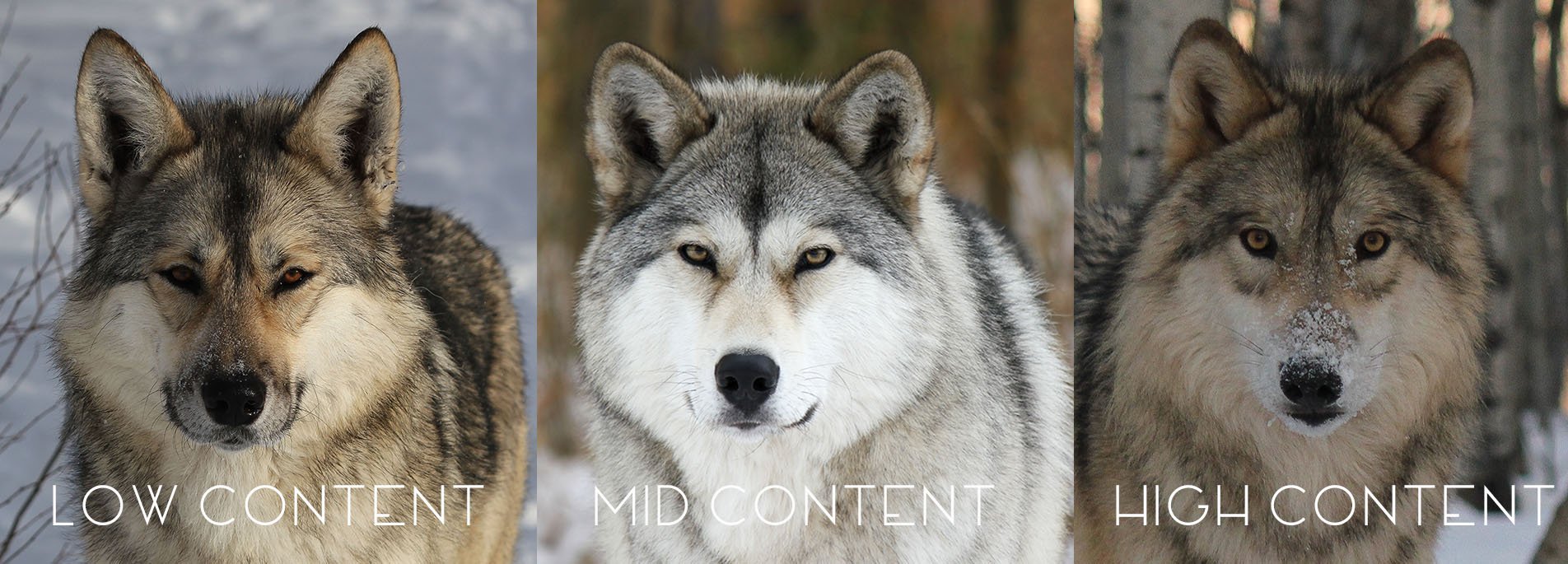
Wolfdog Basics
What is a Wolfdog?
A wolfdog is a canine that contains some amount of wolf content and some amount of dog content. They are classified as low, mid, or high content, which refers to the amount of wolf content present in the animal. Wolfdogs are intentionally bred by humans and often sold as exotic pets. It is rare for wolves and dogs to naturally breed due to territorial and monogamist behaviour, as well as them having different breeding cycles. Wolfdogs often present many challenges, which makes them very difficult to own as pets. Because of this, wolfdogs are often given up by their owners and left with limited places to go. To determine how much wolf content is in a wolfdog, it is simplest to use a process called phenotyping. This is where physical, behavioural and biological traits are assessed.
Nova (high content wolfdog) with Duckie (a Pomeranian X)
-
Wolf Content: approximately 20% - 49%
A low content wolfdog contains more dog content than wolf. Physical traits can vary significantly depending on which dogs breeds are bred into the mix. Low content wolfdogs will typically present some physical wolf traits, but will mainly display dog traits. For example, blue eyes are more likely to be found in a in a low content wolfdog than in a mid content wolfdog, and are almost impossible in a high content wolfdog. This is due to the fact that the gene responsible for blue eyes is recessive and one that is only present in dogs, and not wolves. As such, both parents must be carriers of this gene in order for it to be present in their individual offspring.
Many low content wolfdogs, with the proper socialization and training, are suitable to be pets in the right home. However, they still present challenges and require an owner that is experienced with canines and understands how to manage their behaviours. Some challenges present in a low content wolfdog may include uncertainty towards new people, higher than normal prey drives, the ability to escape containment, and destructive tendencies when left unsupervised indoors. These behaviours can be similar to those displayed by many northern breeds and similar types of dogs such as huskies and malamutes.
-
Wolf Content: approximately 50% - 79%
A mid content wolfdog looks more similar to a wolf and displays significantly more challenging behaviours than a low content wolfdog, but still presents some obvious dog traits. They may have a shorter muzzle, smaller paws, differing eye-colours, multi-coloured nails, or a variation in ear shape that is not present in pure wolves.
Mid content wolfdogs do not make good pets. If raised appropriately, they may be comfortable indoors, crave attention from people, and be adaptable to new places. However, they are much more likely to retain a variety of instinctual wolf behaviours. Common challenges present in a mid content wolfdog can be similar to that of a low content wolfdog, but usually are displayed at a greater intensity and are compounded on one another. Additional challenges may include behaviours such as same sex aggression, resource guarding, territorial tendencies, and a much more pronounced fear of anything out of the ordinary.
-
Wolf content: approximately 80% to 95+%
A high content wolfdog contains a very small amount of dog content. This makes them more comparable to wolves in their physical, behavioural, and biological traits. High content wolfdogs do not make suitable pets. Wolves are naturally fearful towards humans, are very territorial, have strong prey drives, and lack the desire to please humans. These are characteristics that also apply to high content wolfdogs. The majority of their behaviour is instinctual, making it difficult to change or influence. High content wolfdogs require large spaces with extensive fencing to prevent their natural inclination and ability to escape.
A high content wolfdog presents physical traits similar to a pure wolf. They have long legs, a lean body and narrow chest, a long and slender muzzle, thick coats, and a solid black nose. Their eye colours range from amber to yellow to green. Breeding patterns are very similar to wolves, with high content wolfdogs having only one breeding cycle annually. Typically, female heat cycles occur in January while males become fertile between December and January. Puppies are always born in late April to early May. As such, all of the high content wolfdogs at the Sanctuary celebrate their birthdays in the Spring.

















Wolfdog misrepresentation is an essential topic when it comes to wolfdog education, and it has major implications for wolfdog ownership.
In this article, we will discuss some critical aspects of wolfdog misrepresentation that one should know before obtaining a wolfdog.